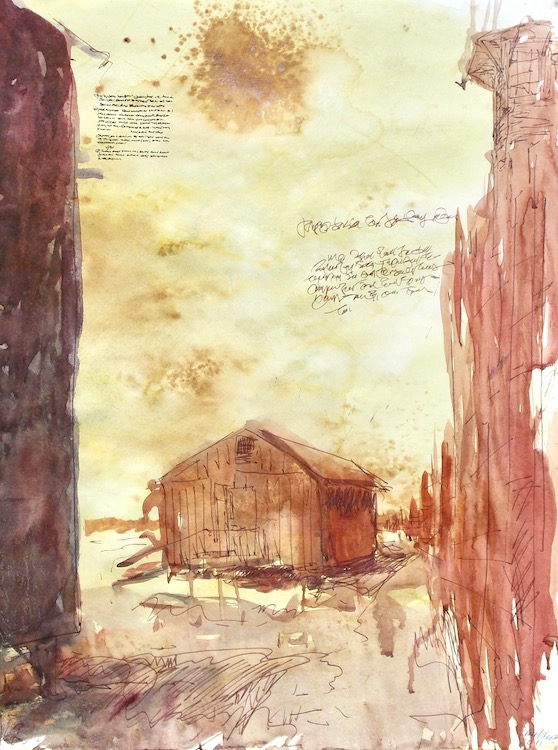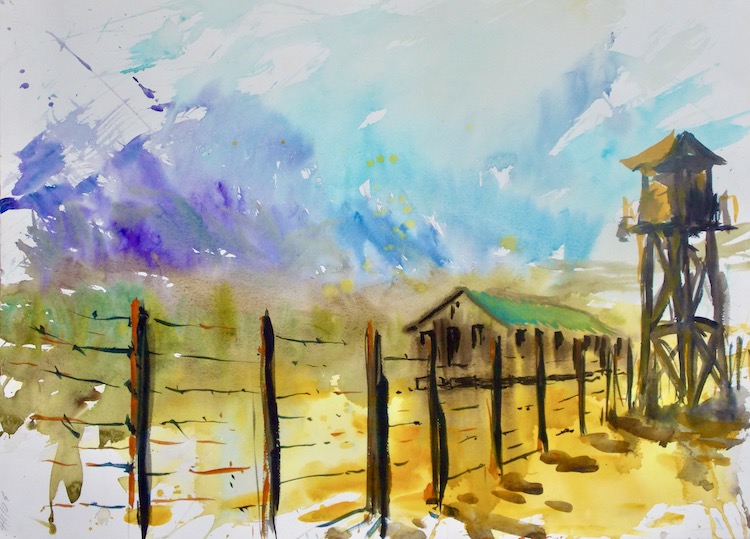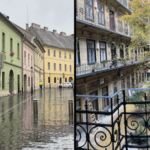Consistency is the hallmark of a well-developed body of work and this is precisely what we see from Chris Hero. While he is adept at many mediums, including watercolors, oils, and acrylics, he views the problem of medium as a “logistical issue, not an artistic one.” The materials are secondary to the message, which always rings loud and clear: How nations, near and far, inflict harm on minority communities.
There is quiet poetry in his paintings of Manzanar, one of the most infamous of the internment camps that forcibly held Japanese Americans during World War II. Manzanar, like other camps scattered across the western US, was in a barren and remote location, and the conditions were described by survivors as “prison-like.” Hero’s work captures the harshness of life, the feeling of isolation, and the sense of displacement that detainees must have felt. Yet he also documents hints of life, hope, and resilience in the purple hues of the horizon and the bright reds of laundry on the line.
In South African Rhino we see the outlines of sketchbook paper hurriedly torn from its notebook, with frayed edges and a mottled palette of grays and browns with hints of pink and blue dancing in the background. The title invites you to interrogate the way militarized vehicles became an ever-present, almost naturalized part of the South African landscape under apartheid.
The theme of state-sanctioned violence, surveillance, and control is on full display in the paintings Night Time Street Show and Night Show Venice. In the same way that the rhino symbolized the familiarity of oppression in South Africa, the always-hovering helicopters above urban California watch ceaselessly as a way to remind the marginalized of their outcast status.
Every hero needs an origin story, and Chris Hero describes his start as “a good southern boy who washed out of NavyROTC in the 70s.” It was his work as a paramedic and as a Sheriff’s deputy, however, that gave him firsthand knowledge of governmental abuse and corruption. After being fired for reporting a police officer for brutality in the back of his ambulance, he ended up as a pariah in a department with its own scandals to hide. Perhaps that’s what convinced him he had a different path to walk. Today, his statement of purpose is “I’d like to make art for a better world, even if just a little.”
—April Sunami, Visual Arts Editor
 Letter from Manazar
Letter from Manazar
 Manazar Camp X Ray Ghost
Manazar Camp X Ray Ghost
 Police Community Relations
Police Community Relations
 South African Rhino
South African Rhino
 The Night Show Venice
The Night Show Venice
 The Nighttime Street Show
The Nighttime Street Show
Chris Hero
Chris Hero holds a BA degree in History from Loyola Univ., New Orleans, an MFA from Cal. State, Long Beach, an expired paramedic license from Tulane University, and a handshake from the New Orleans Academy of Fine Arts. He has worked as a paramedic, a file clerk, art teacher, an attempt at US Navy midshipman, a police officer, a stagehand, and an artist.








